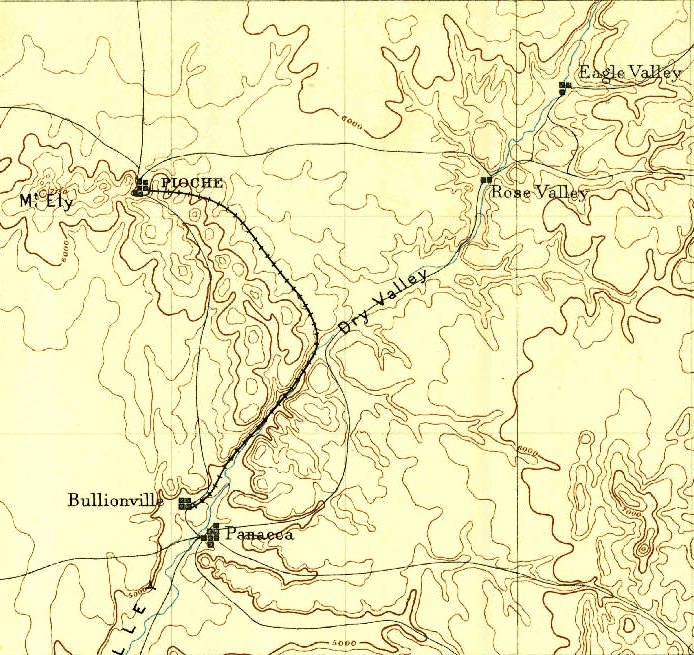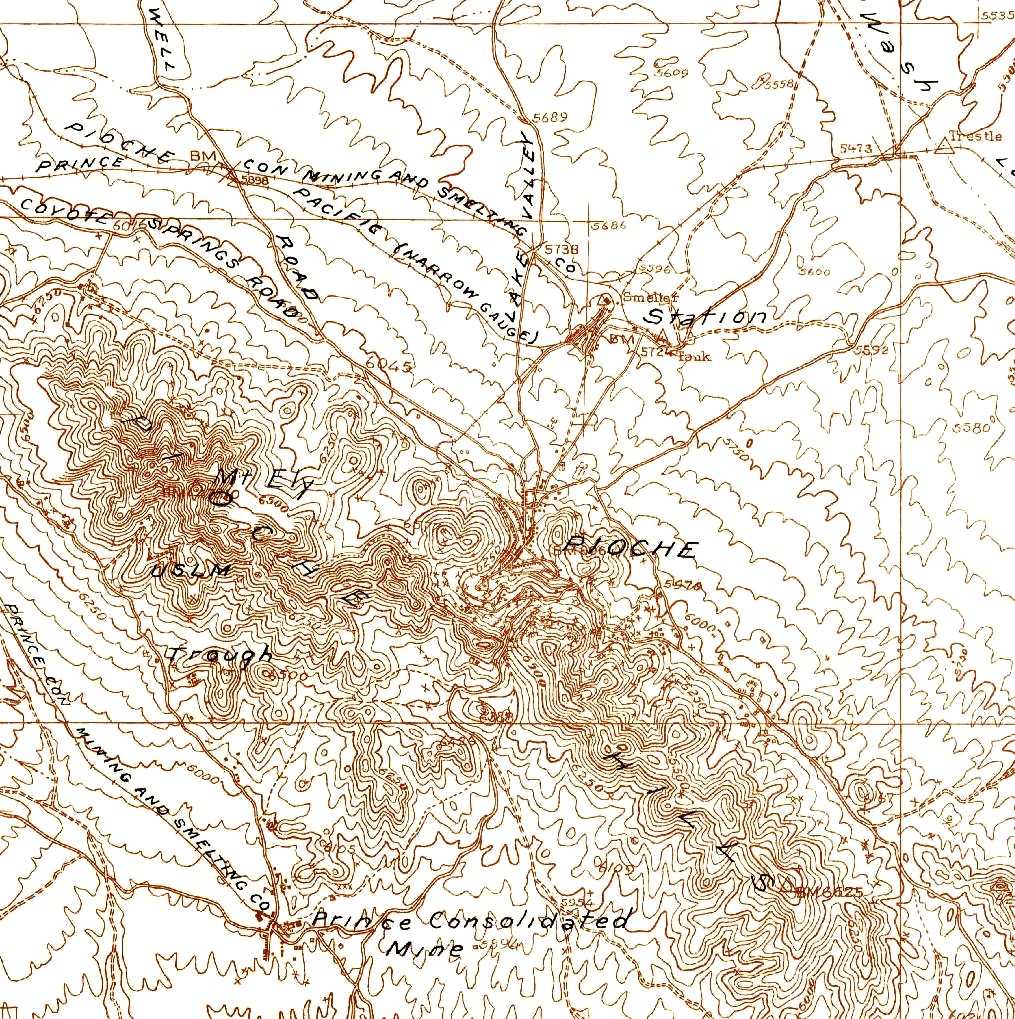|
Pioche, Nevada
Pioche is an unincorporated town in Lincoln County, Nevada, United States, approximately northeast of Las Vegas. U.S. Route 93 is the main route to Pioche and bypasses the town center just to the east, with Nevada State Route 321 and Nevada State Route 322 providing direct access. Its elevation is above sea level. Pioche is the county seat of Lincoln County. Pioche is named after François Louis Alfred Pioche, a San Francisco financier and land speculator originally from France. The town's population was 1,002 at the 2010 census. Demographics History The first modern settlement of the area occurred in 1864 with the opening of a silver mine. The settlers abandoned the area when local Indian tribes launched a series of raids and massacres. Recolonization was launched in 1868, after the Indian raids were stopped and François Pioche bought the town in 1869. By the early 1870s, Pioche had grown larger, to become one of the most important silver-mining towns in Nevada ... [...More Info...] [...Related Items...] OR: [Wikipedia] [Google] [Baidu] |
Unincorporated Towns In Nevada
Nevada state law allows for governance of unincorporated towns under two different systems. The Unincorporated government Law, adopted in 1975, applies to counties of 100,000 people or more, and any other county that opts in. For other counties, a patchwork system of laws applies. A 1975 study by the state Legislative Commission identified 39 unincorporated towns in Nevada. As of 2014, the state Demographer's Office listed 44 unincorporated towns. Unincorporated Town Government Law The Unincorporated Town Government Law, adopted in 1975, applies to counties with a population over 100,000 (Clark Clark is an English language surname, ultimately derived from the Latin with historical links to England, Scotland, and Ireland ''clericus'' meaning "scribe", "secretary" or a scholar within a religious order, referring to someone who was educate ... and Washoe Counties), and any other county whose commissioners pass an ordinance adopting the law. Under this law, unincorporated towns are ... [...More Info...] [...Related Items...] OR: [Wikipedia] [Google] [Baidu] |
Financier
An investor is a person who allocates financial capital with the expectation of a future return (profit) or to gain an advantage (interest). Through this allocated capital most of the time the investor purchases some species of property. Types of investments include equity, debt, securities, real estate, infrastructure, currency, commodity, token, derivatives such as put and call options, futures, forwards, etc. This definition makes no distinction between the investors in the primary and secondary markets. That is, someone who provides a business with capital and someone who buys a stock are both investors. An investor who owns stock is a shareholder. Types of investors There are two types of investors: retail investors and institutional investors. Retail investor * Individual investors (including trusts on behalf of individuals, and umbrella companies formed by two or more to pool investment funds) * Angel investors (individuals and groups) * Sweat equity investor Ins ... [...More Info...] [...Related Items...] OR: [Wikipedia] [Google] [Baidu] |
Semi-arid Climate
A semi-arid climate, semi-desert climate, or steppe climate is a dry climate sub-type. It is located on regions that receive precipitation below potential evapotranspiration, but not as low as a desert climate. There are different kinds of semi-arid climates, depending on variables such as temperature, and they give rise to different biomes. Defining attributes of semi-arid climates A more precise definition is given by the Köppen climate classification, which treats steppe climates (''BSk'' and ''BSh'') as intermediates between desert climates (BW) and humid climates (A, C, D) in ecological characteristics and agricultural potential. Semi-arid climates tend to support short, thorny or scrubby vegetation and are usually dominated by either grasses or shrubs as it usually can't support forests. To determine if a location has a semi-arid climate, the precipitation threshold must first be determined. The method used to find the precipitation threshold (in millimeters): *multiply by ... [...More Info...] [...Related Items...] OR: [Wikipedia] [Google] [Baidu] |
Pioche Town Hall
Pioche is an unincorporated town in Lincoln County, Nevada, United States, approximately northeast of Las Vegas. U.S. Route 93 is the main route to Pioche and bypasses the town center just to the east, with Nevada State Route 321 and Nevada State Route 322 providing direct access. Its elevation is above sea level. Pioche is the county seat of Lincoln County. Pioche is named after François Louis Alfred Pioche, a San Francisco financier and land speculator originally from France. The town's population was 1,002 at the 2010 census. Demographics History The first modern settlement of the area occurred in 1864 with the opening of a silver mine. The settlers abandoned the area when local Indian tribes launched a series of raids and massacres. Recolonization was launched in 1868, after the Indian raids were stopped and François Pioche bought the town in 1869. By the early 1870s, Pioche had grown larger, to become one of the most important silver-mining towns in Nevad ... [...More Info...] [...Related Items...] OR: [Wikipedia] [Google] [Baidu] |
Boot Hill
Boot Hill, or Boothill, is the given name of many cemeteries, chiefly in the Western United States. During the 19th and early 20th century it was a common name for the burial grounds of gunfighters, or those who " died with their boots on" (i.e., violently). Origin of term Although many towns use the name "Boot Hill," the first graveyard named "Boot Hill" was at Hays, Kansas, 5 years before the founding of Dodge City, Kansas. The term alludes to the fact that many of its occupants were cowboys who "died with their boots on," the implication here being they died violently, as in gunfights or by hanging, and not of natural causes. The term became commonplace throughout the Old West, with some Boot Hills becoming famous, such as Dodge City, Kansas, Tombstone, Arizona, and Deadwood, South Dakota. Boothill Graveyard The most notable use of the name "Boot Hill" is at the Boothill Graveyard in Tombstone, Arizona. Formerly called the "Tombstone Cemetery", the plot features the grav ... [...More Info...] [...Related Items...] OR: [Wikipedia] [Google] [Baidu] |
Gunfight
A shootout, also called a firefight or gunfight, is a fight between armed combatants using firearms. The term can be used to describe any such fight, though it is typically used to describe those that do not involve military forces or only involve firearms (thus excluding crew-served weapons, combat vehicles, armed aircraft, or explosives). Shootouts often pit law enforcement against criminals, though they can also involve groups outside of law enforcement, such as rivalling gangs, militias, or individuals. Military combat situations are rarely called "shootouts", and are almost always considered battles, engagements, or skirmishes. Shootouts are often depicted in action films, Westerns, and video games. Notable shootouts in the United States and territories Gunfight on Vine Street May 30, 1856. The Gunfight involved Judge Bird, Dr. Troy, Dr. Hunter, Colonel John R. Bell and his two sons (Charles and John Bell) and took place in Cahaba, Alabama, the former State Capitol of ... [...More Info...] [...Related Items...] OR: [Wikipedia] [Google] [Baidu] |
David Neagle
David Butler Neagle (October 10, 1847—November 28, 1925) was a Deputy U.S. Marshal who, while guarding Associate Supreme Court Justice Stephen Johnson Field, Stephen J. Field, killed former California Chief Justice David S. Terry when he assaulted Field. Neagle was arrested by the county sheriff and charged with murder. Insisting he was acting within his capacity as a federal marshal, his case went to the U.S. Supreme Court, which in ''In re Neagle'' affirmed the executive branch's right to protect judges and the supremacy of federal law over state law. He met Bertha Blanch in 1870. They had two daughters, Louisa and Emma, who died before their sixth birthday. They were married in 1874 and later had Winifred Mary and Albert Victor. He was also a saloon owner, miner and deputy town marshal in Tombstone, Arizona Territory shortly after the Gunfight at the OK Corral. Early life Neagle was the son of Irish immigrants William Neagle and Bridget (née) Donahue. He was born in Bo ... [...More Info...] [...Related Items...] OR: [Wikipedia] [Google] [Baidu] |
Jim Leavy (gunfighter)
James H. Leavy (1842 – June 5, 1882) was an Irish gunfighter in the Old West. He is remembered today by Western historians for participating in at least two instances of a quick draw duel. In his time, Leavy was one of the most notorious gunmen in the Old West known for challenging other gunmen to a duel. He is featured in the book ''Deadly Dozen'', written by author Robert K. DeArment as one of the twelve most underrated gunmen of the 19th century West. Historian Erik J. Wright notes that Leavy's name was in fact spelled "Leavy" as it was spelled this way on a number of primary documents from his time in Nevada and Arizona. Early life Jim Leavy was born in Dublin, Ireland in 1842. While some historians claim Leavy was of Jewish descent, no proof of this exists. All contemporary sources spell his name "Leavy."LEAVY'S MURDERERS< ... [...More Info...] [...Related Items...] OR: [Wikipedia] [Google] [Baidu] |
Old West
The American frontier, also known as the Old West or the Wild West, encompasses the geography, history, folklore, and culture associated with the forward wave of American expansion in mainland North America that began with European colonial settlements in the early 17th century and ended with the admission of the last few western territories as states in 1912 (except Alaska, which was not admitted into the Union until 1959). This era of massive migration and settlement was particularly encouraged by President Thomas Jefferson following the Louisiana Purchase, giving rise to the expansionist attitude known as "Manifest Destiny" and the historians' " Frontier Thesis". The legends, historical events and folklore of the American frontier have embedded themselves into United States culture so much so that the Old West, and the Western genre of media specifically, has become one of the defining periods of American national identity. The archetypical Old West period is generally ac ... [...More Info...] [...Related Items...] OR: [Wikipedia] [Google] [Baidu] |
Silver
Silver is a chemical element with the Symbol (chemistry), symbol Ag (from the Latin ', derived from the Proto-Indo-European wikt:Reconstruction:Proto-Indo-European/h₂erǵ-, ''h₂erǵ'': "shiny" or "white") and atomic number 47. A soft, white, lustrous transition metal, it exhibits the highest electrical conductivity, thermal conductivity, and reflectivity of any metal. The metal is found in the Earth's crust in the pure, free elemental form ("native silver"), as an alloy with gold and other metals, and in minerals such as argentite and chlorargyrite. Most silver is produced as a byproduct of copper, gold, lead, and zinc Refining (metallurgy), refining. Silver has long been valued as a precious metal. Silver metal is used in many bullion coins, sometimes bimetallism, alongside gold: while it is more abundant than gold, it is much less abundant as a native metal. Its purity is typically measured on a per-mille basis; a 94%-pure alloy is described as "0.940 fine". As one of th ... [...More Info...] [...Related Items...] OR: [Wikipedia] [Google] [Baidu] |



.jpg)



